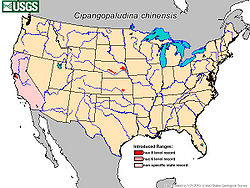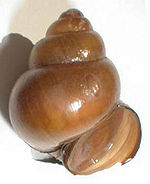Chinese mystery snail
| Chinese mystery snail |
|---|

|
| Scientific Classification |
|
| Binomial Name |
|
Bellamya chinensis |
| Synonyms |
|
| Cipangopaludina chinensis range map |
Chinese mystery snail is a species of freshwater aquatic snails known by the scientific name Bellamya chinensis, and is also known as the Japanese mystery snail. As their name implies, they are native to Asia, and are assigned to the Viviparidae family [1], which means it gives birth to live young.
They are a preferred snail for water gardening because they scour the pond eating algae off the liner, planters and even cleaning up your plants without harming them.[2]. They have gills for breathing underwater, and a distinct trapdoor (operculum) that they can close tight to provide resistance to drought and predation. [3].
Anatomy
A major way to identify these snails is to look at their large size [4].Some species of adult Chinese mystery snails can grow to be 1 1/2 inches in length or smaller. Chinese mystery snails are measured from the lip of the shell to the tip of the spiral, and its shell is smooth and strong. They all show corrosion on the spiral of their shell [5], it can have 6 to 7 spirals [6]. Another characteristic of the Chinese mystery snail is the operculum, or trap door, at the end of the shell that can be opened and closed[7].Also operculum can be round or ova l[8]. They shell may vary from typically a light to dark olive green, the color is uniform, there is no banding[9]. Unlike many snails, Chinese mystery snails do not breathe air. They stay in the pond unless they are removed. If they are removed from the water, they close their operculum until returned into the water [10].
Reproduction
Chinese mystery snails reproduce sexually and are viviparous, so the females give birth to live young [11]. If you look into an adult female snail, you might be able to see smaller snails in it [12]. The young feed off zooplankton and phytoplankton [13].The female Chinese mystery snail has one antenna longer than the other and the female had same size antennas. The antenna is the snail's sex organs [14]. They reproduce quickly; it only takes one impregnated snail to start a whole new population. The density of the population can range from 3 to 6 feet of water depth [15].
Ecology
Habitat
Chinese mystery snails are found in silt and mud of marshes and creeks,[16]. They can also be found in lakes, ponds, and rice paddies [17] and in water depths of 1.5 to 15 ft [18]. These freshwater snails are native to Burma, China, Korea, Japan, the Philippines, Java, and Asiatic Russia in the Amur region. They were introduced in at least 27 states, especially in the Northeast and the Great Lakes region [19].
They wil die when they are in lakes with low oxygen and warm water. They cannot move into deep water because they can't tolerate the low oxygen levels and high temperatures [20]. However, They can handle pollution and stagnation in water, not many snails can thrive in such an environment [21].
Feeding Chinese mystery snails do not eat plants, they are detritivores. They may also eat small amounts algae and phytoplankton [22]. They are good to have in aquariums because they don’t eat fish eggs or plants, and they can close up if there is a problem with the water. This indicates the problem to people so that it can be corrected.[23]
Impact in the USA
In 1892 Chinese mystery snails where first introduced into live markets in San Francisco and in 1911 they were found in the San Francisco Bay. Then they spread everywhere, from the west coast to the east coast. Also great Lakes; Lake Michigan and Lake Erie where affected by the snails in 1956.Chinese mystery snails where brought into the USA for Asian food markets and they were probably released into the waters to make them a local food source [24]. They have become a major threat to us because they are clogging pipelines and blocking water passage [25]. Another reason why the Chinese mystery snail has become a threat is because it is now a vector for the transmission of many parasites and diseases. Some of the parasites or diseases that host the Chinese mystery snail have been known to affect humans[26].
Biological control
Specific control methods for this snail still need to be developed, but are still some general forms. Most people think that biological control is the best because it creates less damage to other aquatic organisms. Fish or turtles are added to the area and they eat the snails, lowering the population[27].
- Puffers
- Loaches
- Snail-eating turtles
- Fish[28]
Chemical Control
Another method is to use chemical control. A copper compound can be introduced into the water and it will kill the snail. The downside of using chemical is that it does not kill a specific snail, it kill all of them. Chinese snails can close their operculum so this method might not work and other native snails might be killed[29].
How to Monitor Chinese mystery snails
For 10 minutes make a quick search along the lake shore line. Walk along the shore and look for shells on the shore and in the shallow waters. If you find shells before the 10 minutes are up, you don’t need to keep on looking. Same if you don’t find any shells at all, there is no need to keep on looking after the 10 minutes are up. When you have your data, you can share it for others to see. The information you report can be given to the state legislature, federal, tribal and local agencies/organizations. This way your data can help them determine how much funding will be invested for invasive species grants and programs[30].
References
- The Oriental Mystery Mollusc (Cipangopaludina chinensis) at Buckhorn Island State Park, Erie County, New York P.M. Eckel,Res Botanica, August 3, 2009.
- Chinese mystery snail Wikipedia, wikipedi.com,accessed date Nov.23, 2010.
- CHINESE MYSTERY SNAIL author unknown, Aquatic Invasive Species, accessed date Nov.23, 2010.
- Japanese Trapdoor Snails Finch Family, Finch Family Watergarden, accessed date Nov 23, 2010.
- Chinese Mystery Snail author unknown, Aquatic Community, assecced date Nov 23, 2010.
- Guide to Crayfish and Chinese Mystery Snail Identification in WAJulian Olden,University of Washington, July 2009.
- Article: Battling the Chinese mystery snail Power, Highbeam.com, June 1, 2009.
- Mystery Snail Monitoring Protocol author unknown, Citizen Lake Monitoring Network, accessed date Dec. 08,2010.
- Chinese (Oriental) Mystery Snail Stacey A. Bataran, www.iisgcp.org, accessed date Dec. 08, 2010.
- Mystery Snails author unknown, www.uwsp.edu, accessed date Dec. 08, 2010.



